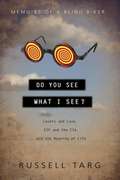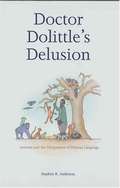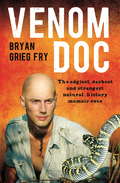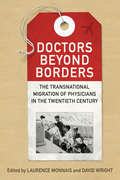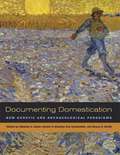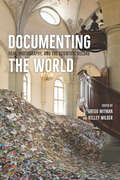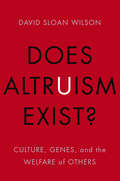- Table View
- List View
Do We Really Understand Quantum Mechanics?
by Franck LaloëQuantum mechanics impacts on many areas of physics from pure theory to applications. However it is difficult to interpret, and philosophical contradictions and counter-intuitive results are apparent at a fundamental level. This book presents current understanding of the theory, providing a historical introduction and discussing many of its interpretations. Fully revised from the first edition, this book contains state-of-the-art research including loophole-free experimental Bell test, and theorems on the reality of the wave function including the PBR theorem, and a new section on quantum simulation. More interpretations are now included, and these are described and compared, including discussion of their successes and difficulties. Other sections have been expanded, including quantum error correction codes and the reference section. It is ideal for researchers in physics and maths, and philosophers of science interested in quantum physics and its foundations.
Do You Really Want to Visit a Wetland? (Into Reading, Read Aloud Module 7 #3)
by Bridget Heos Daniele FabbriNIMAC-sourced textbook
Do You See What I See? Memoirs of a Blind Biker
by Russell TargTarg has been visually handicapped since childhood and yet he has performed groundbreaking research in lasers and optics. This book provides the remarkable story of a visually impaired physicist who sees beyond perception to help readers find meaning and joy.
Do Zombies Dream of Undead Sheep?: A Neuroscientific View of the Zombie Brain
by Timothy Verstynen Bradley VoytekA look at the true nature of the zombie brainEven if you've never seen a zombie movie or television show, you could identify an undead ghoul if you saw one. With their endless wandering, lumbering gait, insatiable hunger, antisocial behavior, and apparently memory-less existence, zombies are the walking nightmares of our deepest fears. What do these characteristic behaviors reveal about the inner workings of the zombie mind? Could we diagnose zombism as a neurological condition by studying their behavior? In Do Zombies Dream of Undead Sheep?, neuroscientists and zombie enthusiasts Timothy Verstynen and Bradley Voytek apply their neuro-know-how to dissect the puzzle of what has happened to the zombie brain to make the undead act differently than their human prey.Combining tongue-in-cheek analysis with modern neuroscientific principles, Verstynen and Voytek show how zombism can be understood in terms of current knowledge regarding how the brain works. In each chapter, the authors draw on zombie popular culture and identify a characteristic zombie behavior that can be explained using neuroanatomy, neurophysiology, and brain-behavior relationships. Through this exploration they shed light on fundamental neuroscientific questions such as: How does the brain function during sleeping and waking? What neural systems control movement? What is the nature of sensory perception?Walking an ingenious line between seriousness and satire, Do Zombies Dream of Undead Sheep? leverages the popularity of zombie culture in order to give readers a solid foundation in neuroscience.
Do you Really Want to Meet A Tiger
by Cari MeisterA child goes on an adventure to Russia as a junior researcher to study tigers in the wild, and learns about this endangered species.
Doable Renewables: 16 Alternative Energy Projects for Young Scientists
by Mike RigsbyKids will learn valuable hands-on lessons from this guide by constructing working models that generate renewable, alternative energy. Budding scientists learn how to build their own Kelvin water-drop generator out of six recycled cans and alligator-clip jumpers; a solar-powered seesaw from a large dial thermometer and a magnifying glass; and a windmill from eight yardsticks, PVC pipe, cardboard, and a converter generator. Children will investigate the energy-generating properties of a solar cell, a radiometer, a Nitinol heat engine, and a Peltier cell--there are even plans to build a human-powered desk lamp. Each project includes a materials and tools list as well as online information on where to find specialized components.
Docking Screens for Drug Discovery (Methods in Molecular Biology #2053)
by Walter Filgueira De Azevedo Jr.This book focuses on recent developments in docking simulations for target proteins with chapters on specific techniques or applications for docking simulations, including the major docking programs. Additionally, the volume explores the scoring functions developed for the analysis of docking results and to predict ligand-binding affinity as well as the importance of docking simulations for the initial stages of drug discovery. Written for the highly successful Methods in Molecular Biology series, this collection presents the kind of detail and key implementation advice to ensure successful results. Authoritative and practical, Docking Screens for Drug Discovery aims to serve those interested in molecular docking simulation and also in the application of these methodologies for drug discovery.
Doctor Dolittle’s Delusion: Animals and the Uniqueness of Human Language
by Stephen R. AndersonCan animals be taught a human language and use it to communicate? Or is human language unique to human beings, just as many complex behaviors of other species are uniquely theirs? This engrossing book explores communication and cognition in animals and humans from a linguistic point of view and asserts that animals are not capable of acquiring or using human language. Stephen R. Anderson explains what is meant by communication, the difference between communication and language, and the essential characteristics of language. Next he examines a variety of animal communication systems, including bee dances, frog vocalizations, bird songs, and alarm calls and other vocal, gestural, and olfactory communication among primates. Anderson then compares these to human language, including signed languages used by the deaf. Arguing that attempts to teach human languages or their equivalents to the great apes have not succeeded in demonstrating linguistic abilities in nonhuman species, he concludes that animal communication systems--intriguing and varied though they may be--do not include all the essential properties of human language. Animals can communicate, but they can't talk.
Doctor Robot-O
by Lela NargiCan you imagine visiting a doctor's office for an illness or injury, but getting treated by a robot instead? According to some researchers, this could be the reality in the not too distant future. Ongoing research into artificial intelligence and its use in medicine might someday produce robots that will work alongside human doctors and nurses to deliver the best health care possible.
Doctor Venom
by Bryan Grieg FryMeet venomologist Bryan Grieg Fry, the man with one of the most dangerous job in Australia - working with the world's most deadly creatures.Welcome to the strange and dangerous world of Doctor Venom.Imagine a first date involving three weeks in Siberia catching venomous water shrews, and later a wedding attended by Eastern European prime ministers and their bodyguards wielding machine guns. Then a life of living and working with snakes. Lots of very, very poisonous snakes and other venomous creatures ... everything from the Malaysian king cobra to deadly scorpions.In this action-packed ride through Bryan Grieg Fry's life you'll meet the man who's worked with the world's most venomous creatures in over 50 countries. He's been bitten by 26 poisonous snakes and three stingrays - and, while deep in the Amazon jungle, survived a near-fatal scorpion sting. He's also broken 23 bones, including breaking his back in three places, and had to learn how to walk again. He only works on venom that he has collected himself - so the adventures, and danger, will just keep coming...Bryan now divides his time between scientific research and teaching at the University of Queensland, and TV filming and collecting expeditions around the world.
Doctor Who: a 1980s story
by Mark Griffiths Doctor Who*Part of the six books for six decades collection*Midnight, 1984.In a sprawling, run-down housing estate in south London, a man returning from a night out in the West End finds himself pursued by a strange hooded figure.So naturally when the Doctor and Romana arrive in the TARDIS the next day, they find themselves in the middle of a crime scene.But when child genius Matthew Pickles - inventor of a hugely popular handheld videogame - arrives to help them crack the case, they discover there is more to this than meets the eye.Someone has been messing with technology that's not of this earth, blurring the lines between human . . . and cyber. And it looks like they're out for revenge.In a world on the brink of gadgets and gismos and dangerous tech, the pair must uncover the killer, before they strike again.
Doctored: Fraud, Arrogance, and Tragedy in the Quest to Cure Alzheimer's
by Charles Piller&“Demonstrates how some of the most accomplished and elite scientific gatekeepers may have lied, cheated, squandered trust and endangered lives.&” —The Wall Street Journal For readers of Empire of Pain and Dopesick, an arresting deep dive into how Alzheimer&’s disease treatment has been set back by corrupt researchers, negligent regulators, and the profit motives of Big Pharma. Nearly seven million Americans live with Alzheimer&’s disease, a tragedy that is already projected to grow into a $1 trillion crisis by 2050. While families suffer and promises of pharmaceutical breakthroughs keep coming up short, investigative journalist Charles Piller&’s Doctored shows that we&’ve quite likely been walking the wrong path to finding a cure all along—led astray by a cabal of self-interested researchers, government accomplices, and corporate greed. Piller begins with a whistleblower—Vanderbilt professor Matthew Schrag—whose work exposed a massive scandal. Schrag found that a University of Minnesota lab led by a precocious young scientist and a Nobel Prize–rumored director delivered apparently falsified data at the heart of the leading hypothesis about the disease. Piller&’s revelations of Schrag&’s findings stunned the field and the public. From there, based on years of investigative reporting, this &“seminal account of deceit that will long be remembered&” (Katherine Eban, author of Bottle of Lies and Vanity Fair special correspondent) exposes a vast network of deceit and its players, all the way up to the FDA. Piller uncovers evidence that hundreds of important Alzheimer&’s research papers are based on false data. In the process, he reveals how even against a flood of money and influence, a determined cadre of scientific renegades have fought back to challenge the field&’s institutional powers in service to science and the tens of thousands of patients who have been drawn into trials to test dubious drugs. It is a shocking tale with huge ramifications not only for Alzheimer&’s disease, but for scientific research, funding, and oversight at large.
Doctors (People In My Community)
by Jacqueline Laks GormanWe usually take trips to the doctor when we’re sick, so it’s easy to undervalue this very important community member, but this book invites readers to change their minds and celebrate the role. Readers will learn about a doctor’s duties, where they work, and the tools they use to keep us feeling healthy.
Doctors Are More Harmful Than Germs: How Surgery Can Be Hazardous to Your Health and What to Do About It
by Lisa Haller Harvey BigelsenMost people would consider a knife wound to the stomach a serious health risk, but a similar scalpel wound in an operating room is often shrugged off. In Doctors Are More Harmful Than Germs, Dr. Harvey Bigelsen explains how today's medical doctors overprescribe surgery and ignore its long-term health implications. Any invasive medical procedure, he argues--including colonoscopies and root canals--creates inflammation in the body, leading to serious and long-lasting health problems. Inflammation, according to Dr. Bigelsen, is the real cause of all chronic disease (persistent or long-lasting illness). Noting that Western medicine has yet to "cure" a single chronic disease, Bigelsen points to a new paradigm: one that treats each patient as an individual (rather than as a set of symptoms), avoids further damage to the body through surgery, and looks for the root cause of chronic disease in past damage done to the patient's body--whether caused by a bad fall or a scalpel. Provocatively written and radical in its approach, Doctors Are More Harmful Than Germs challenges readers to rethink everything they believe about illness and how to treat it.
Doctors In Our Community (On The Job)
by Erin HeathFrom putting a cast on a broken leg to performing lifesaving surgery, a doctor s job is challenging and rewarding. Your readers will see what it s like to have this incredible job.
Doctors beyond Borders: The Transnational Migration of Physicians in the Twentieth Century
by David Wright Laurence MonnaisThe transnational migration of health care practitioners has become a critical issue in global health policy and ethics. Doctors beyond Borders provides an essential historical perspective on this international issue, showing how foreign-trained doctors have challenged - and transformed - health policy and medical practice in countries around the world.Drawing on a wide variety of sources, from immigration records and medical directories to oral histories, the contributors study topics ranging from the influence of South Asian doctors on geriatric medicine in the United Kingdom to the Swedish reaction to the arrival of Jewish physicians fleeing Nazi Germany and the impact of the Vietnam War on the migration of doctors to Canada. Combining social history, the history of health and medicine, and immigration history, Doctors beyond Borders is an impressive selection of essays on a topic that continues to have global relevance.
Doctors by Nature: How Ants, Apes, and Other Animals Heal Themselves
by Jaap de RoodeThe astonishing story of how animals use medicine and what it can teach us about healing ourselvesAges before the dawn of modern medicine, wild animals were harnessing the power of nature&’s pharmacy to heal themselves. Doctors by Nature reveals what researchers are now learning about the medical wonders of the animal world. In this visionary book, Jaap de Roode argues that we have underestimated the healing potential of nature for too long and shows how the study of self-medicating animals could impact the practice of human medicine.Drawing on illuminating interviews with leading scientists from around the globe as well as his own pioneering research on monarch butterflies, de Roode demonstrates how animals of all kinds—from ants to apes, from bees to bears, and from cats to caterpillars—use various forms of medicine to treat their own ailments and those of their relatives. We meet apes that swallow leaves to dislodge worms, sparrows that use cigarette butts to repel parasites, and bees that incorporate sticky resin into their hives to combat pathogens. De Roode asks whether these astonishing behaviors are learned or innate and explains why, now more than ever, we need to apply the lessons from medicating animals—it can pave the way for healthier livestock, more sustainable habitats for wild pollinators, and a host of other benefits.Doctors by Nature takes readers into a realm often thought to be the exclusive domain of humans, exploring how scientists are turning to the medical knowledge of the animal kingdom to improve agriculture, create better lives for our pets, and develop new pharmaceutical drugs.
Doctrine and Disease in the British and Spanish Colonial World
by Kathleen MillerDuring the early modern period, unprecedented migration caused diseases to take hold in new locales, turning illness and the human body into battlegrounds for competing religious beliefs as well as the colonial agendas in which they were often ensnared. This interdisciplinary volume follows the contours of illness, epidemics, and cures in the early modern British and Spanish Empires as these were understood in religious terms.Each chapter of this volume centers on a key moment during this period of remarkable upheaval, including Jesuit co-optation of Indigenous knowledge in Peru, the Catholic Church’s dissemination of the smallpox vaccine across the Spanish Empire, Puritan collective fasting during smallpox outbreaks, and the practice of eating dirt as Obeah resistance among enslaved people in Jamaica. Throughout, the contributors explore how the porous geographical borders of the transatlantic world meant that medicine and religion were translated through and against each other, over and over again. Residing at the nexus between two largely discrete areas of inquiry, this collection provides significant insight into the numerous points of juncture between medicine and religion in the Atlantic world.In addition to the editor, the contributors to this volume include Matthew James Crawford, Crawford Gribben, Rana A. Hogarth, Philippa Koch, Allyson M. Poska, Catherine Reedy, and Rebecca Totaro.
Documenting Domestication: New Genetic and Archaeological Paradigms
by Melinda A. Zeder Daniel G. Bradley Eve Emshwiller Bruce D. SmithThis volume brings together leading archaeologists and biologists working on the domestication of both plants and animals to consider a wide variety of archaeological and genetic approaches to tracing the origin and dispersal of domesticates.
Documenting the World: Film, Photography, and the Scientific Record
by Gregg Mitman Kelley WilderImagine the twentieth century without photography and film. Its history would be absent of images that define historical moments and generations: the death camps of Auschwitz, the assassination of John F. Kennedy, the Apollo lunar landing. It would be a history, in other words, of just artists' renderings and the spoken and written word. To inhabitants of the twenty-first century, deeply immersed in visual culture, such a history seems insubstantial, imprecise, and even, perhaps, unscientific. Documenting the World is about the material and social life of photographs and film made in the scientific quest to document the world. Drawing on scholars from the fields of art history, visual anthropology, and science and technology studies, the chapters in this book explore how this documentation--from the initial recording of images, to their acquisition and storage, to their circulation--has altered our lives, our ways of knowing, our social and economic relationships, and even our surroundings. Far beyond mere illustration, photography and film have become an integral, transformative part of the world they seek to show us.
Doença de Alzheimer I
by Carlos Oliveira Juan Moises de la SernaO alzheimer é uma doença que tem crescido em relação ao número de casos de afetados nos últimos anos, o que por sua vez provoca o surgimento de muitas perguntas quando uma pessoa ou um familiar recebe esse diagnóstico, tal como: o que é o Alzheimer? Qual a sua origem? Existe tratamento? Como evolui a doença? Quais consequências acarreta na vida cotidiana? Quais são os efeitos psicológicos sobre o paciente? É possível superar? É transmissível para os filhos? Se abre diante de nós todo um leque de questões relativas à incerteza que é saber que padecemos com uma doença cada vez mais "comum" e estendida, e que apenas se sabe sobre os últimos avanços científicos nesta área, devido, em boa medida, à complexidade da linguagem técnica empregada. E também porque estes avanços tendem a chegar somente aos especialistas através de reuniões e congressos onde se compartilha esse tipo de informação.
Doença de Alzheimer II: Quais são os sintomas?, Como é diagnosticada? e Quantos são afetados?
by Cleiton Cândido da Silva Juan Moises de la SernaO objetivo do e-book é servir como uma primeira aproximação para aqueles que têm em si mesmos ou em sua família, a Doença de Alzheimer. Este livro tenta apresentar claramente os resultados das mais recentes pesquisas sobre a doença de Alzheimer, que respondem as perguntas mais importantes, o que provoca sintomas? Como é diagnosticado? Quantos afetados existem?
Does Altruism Exist?
by David Sloan WilsonDavid Sloan Wilson, one of the world’s leading evolutionists, addresses a question that has puzzled philosophers, psychologists, and evolutionary biologists for centuries: Does altruism exist naturally among the Earth’s creatures? The key to understanding the existence of altruism, Wilson argues, is by understanding the role it plays in the social organization of groups. Groups that function like organisms indubitably exist, and organisms evolved from groups. Evolutionists largely agree on how functionally organized groups evolve, ending decades of controversy, but the resolution casts altruism in a new light: altruism exists but shouldn’t necessarily occupy center stage in our understanding of social behavior. After laying a general theoretical foundation, Wilson surveys altruism and group-level functional organization in our own species—in religion, in economics, and in the rest of everyday life. He shows that altruism is not categorically good and can have pathological consequences. Finally, he shows how a social theory that goes beyond altruism by focusing on group function can help to improve the human condition in a practical sense. Does Altruism Exist? puts old controversies to rest and will become the center of debate for decades to come.
Does Anything Eat Wasps: And 101 Other Questions
by New ScientistEvery year, readers send in thousands of questions to New Scientist, the world's best-selling science weekly, in the hope that the answers to them will be given in the 'Last Word' column - regularly voted the most popular section of the magazine.Does Anything Eat Wasps? is a collection of the best that have appeared, including: Why can't we eat green potatoes? Why do airliners suddenly plummet? Does a compass work in space? Why do all the local dogs howl at emergency sirens? How can a tree grow out of a chimney stack? Why do bruises go through a range of colours? Why is the sea blue inside caves? Many seemingly simple questions are actually very complex to answer. And some that seem difficult have a very simple explanation. New Scientist's 'Last Word' celebrates all questions - the trivial, the idiosyncratic, the baffling and the strange. This selection of the best is popular science at its most entertaining and enlightening.
Does Anything Eat Wasps: And 101 Other Questions
by New ScientistEvery year, readers send in thousands of questions to New Scientist, the world's best-selling science weekly, in the hope that the answers to them will be given in the 'Last Word' column - regularly voted the most popular section of the magazine.Does Anything Eat Wasps? is a collection of the best that have appeared, including: Why can't we eat green potatoes? Why do airliners suddenly plummet? Does a compass work in space? Why do all the local dogs howl at emergency sirens? How can a tree grow out of a chimney stack? Why do bruises go through a range of colours? Why is the sea blue inside caves? Many seemingly simple questions are actually very complex to answer. And some that seem difficult have a very simple explanation. New Scientist's 'Last Word' celebrates all questions - the trivial, the idiosyncratic, the baffling and the strange. This selection of the best is popular science at its most entertaining and enlightening.

